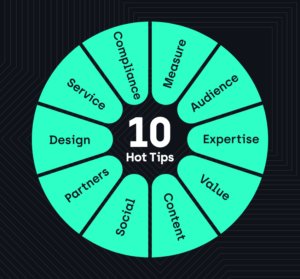When it comes to delivering modern tech solutions to banks and other financial institutions, B2B financial technology companies must put their best foot forward to beat out their competitors. Now, what does that include? For starters, it’s imperative to continually innovate your products and services to meet the demands of the industry. Secondly, a strong marketing strategy will help your organization soar.
According to McKinsey, “revenues in the fintech industry are expected to grow almost three times faster than those in the traditional banking sector between 2022 and 2028. Compared with the six percent annual revenue growth for traditional banking, fintechs could post annual revenue growth of 15 percent over the next five years.”*
With all that market potential, competition in the field will continue to rise. Establish a solid reputation and achieve success in the fintech industry by crafting a sound marketing strategy for the year ahead.
Here are ten quick tips to help you boost the success rate of your fintech marketing and grow your bottom line:

1. Understand Your Audience
One of the fundamental aspects of any successful marketing strategy is understanding your target audience. When it comes to B2B fintech organizations, audiences may include banks, credit unions, insurance companies, investment firms, and more. Identify who your specific buyers are and conduct thorough research to comprehend their pain points, needs, preferences, and challenges. By tailoring your marketing message to meet your target audience’s needs at a more granular level, you’ll find that you more easily resonate with potential customers in the buyer journey.
Market research can be a great tool to help you intimately understand your audience, especially at the early stage of planning your marketing strategy. For instance, if your fintech solution is targeting IT teams at financial institutions, conduct surveys or interviews with existing customers to better understand their issues and how your solution can uniquely solve them. Then, use your key learnings to update your brand and product message across your content and relevant communications channels. To quickly identify whether or not market research is a need for your organization, check out our recent blog that dives into the 10 business situations that need a B2B market research agency.
2. Showcase Your Expertise
To gain trust and credibility among your existing and potential customers, position your company as an industry expert. Share insights, market trends, and thought leadership through blogs, webinars, long-form content, or speaking engagements at industry events. You can host a webinar series featuring subject matter experts at your company discussing the latest industry trends, regulatory changes, and technological advancements. Share these webinars on your website and across your social media platforms to position your company as a trusted source of knowledge. Establishing your authority will make prospective customers more likely to trust and invest in your solutions.
3. Craft a Compelling Value Proposition
Your value proposition represents the core of your marketing efforts. Create a cohesive and powerful message that communicates the unique benefits and advantages of your fintech solution. Highlight how it can save time, reduce costs, enhance security, improve compliance, increase revenue, or solve any other pain points frequently experienced in the financial industry.
Make it easy for potential customers to understand why your solution is the best choice for them. For example, you can clearly outline how your online lending platform can streamline loan approval processes for banks and reduce their operational costs. Emphasize that, by using your solution, banks can process loan applications up to 50% faster, leading to quicker revenue generation. Tangible statistics and other data points are always a great way to grab a customer’s attention with your value proposition. And don’t be afraid to continually build upon your value proposition and revise it as necessary.
4. Utilize Content Marketing
Due to the complexities and questions surrounding fintech, content marketing can be a powerful tool in this sector. Create high-quality, informative content that addresses industry challenges and provides valuable insights for your buyers and share it through your website, social media, webinars, or email to establish your brand as a knowledgeable and trusted resource.
For instance, you can create an in-depth whitepaper explaining how your AI technology can enhance security and transparency in financial transactions. Promote this whitepaper through targeted email campaigns and share it on LinkedIn to attract financial institutions seeking innovative security solutions.
5. Leverage Social Media
Social media is an excellent tool for showcasing your tech and engaging with your audience where they frequent. Use platforms like LinkedIn and Twitter to share industry news, engage in discussions, and connect with potential customers. Consider using paid advertising to reach a broader audience and promote your thought leadership content.
For example, you can use LinkedIn to share success stories about how your digital payment solution helped a bank increase customer satisfaction and transaction efficiency. Encourage satisfied customers to provide testimonials that you can feature in your posts, enhancing your credibility.
6. Build Strong Partnerships
Collaborating with other fintech companies or complementary service providers can be a mutually beneficial experience. Partnering can help you expand your reach and offer more comprehensive solutions to your customers. When selecting potential companies to partner with, look for those that share similar values to yours and can provide value to your customers.
You can consider partnering with a complementary accounting software provider to offer a more holistic experience for your customers. Promote your partnership as a value-added service to both your existing and potential customers, making your fintech offering more comprehensive and appealing.
7. Invest in User-Friendly Design
A user-friendly and visually appealing website is essential for any fintech company. Potential customers should be able to navigate your website easily, understand your solutions, and be able to quickly request more information. An intuitive design can significantly impact the conversion rate of your website visitors.
Additionally, ensure that your fintech platform’s dashboard reflects your overall brand look and feel, and is just as inviting and intuitive as your website. Include interactive tutorials or guided tours to help users navigate your solution effectively, reducing the learning curve and improving user satisfaction.
8. Enhance Your Customer Service
Great customer service can be the deciding factor that makes or breaks a fintech sale for your organization. Happy customers who’ve had optimal and personalized customer service interactions are more likely to become loyal advocates and will end up referring your services to their peers.
Spend time with your employees to help them improve their customer interactions and come to a resolution quicker. Create a manual for them that walks through the steps to solving common customer issues and results in higher CSAT.
9. Highlight Security and Compliance
In the fintech sector, the importance of robust security and stringent compliance cannot be overstated. It’s crucial to ensure that your marketing materials prominently emphasize the advanced security measures and regulatory compliance that your solutions adhere to. Highlight any certifications or audits that underscore your unwavering commitment to safeguarding sensitive financial data.
To visually communicate this, you can create an infographic that illustrates your fintech solution’s multi-layered security infrastructure and demonstrates how it meticulously aligns with industry regulations like GDPR and PCI DSS. Utilize this infographic in your presentations and marketing materials as a compelling visual aid to emphasize your dedication to data protection and regulatory adherence.
10. Measure and Iterate
The ability to adapt and evolve marketing strategies will help you stay competitive and relevant in the industry. Continuous improvement is the key to successful fintech marketing. Employ analytics tools to meticulously track the performance of your marketing efforts and keep a close eye on metrics such as website traffic, conversion rates, and customer acquisition costs.
As an example, you can analyze the conversion rates of your email marketing campaigns over several months. If you find that certain content or subject lines yield better results, use those insights to further refine your future campaigns. Regular adjustments of your marketing strategy and campaigns based on these findings will result in continued optimization and marketing efforts that are both effective and aligned to the evolving needs of your target audience.
Empower Your Fintech Business Now and Into the Future
Effective marketing is essential for B2B fintech companies looking to thrive in a truly competitive industry. By intimately understanding your audience, showcasing expertise in the industry, and delivering a compelling value proposition, you’ll more easily be able to stand out in the market. Utilize content marketing, social media, and strategic partnerships to help expand your reach. And take the time to make your website more user-friendly, prioritize customer support, and emphasize security and compliance in your marketing materials.
With a data-driven approach and a commitment to continuous improvement, your fintech company will be able to successfully market its innovative solutions to businesses in the financial sector. When you’re ready to get started, reach out to the B2B marketing expert team at Yeager to help.
*Fintechs: A new paradigm of growth. https://www.mckinsey.com/industries/financial-services/our-insights/fintechs-a-new-paradigm-of-growth. McKinsey & Company.

